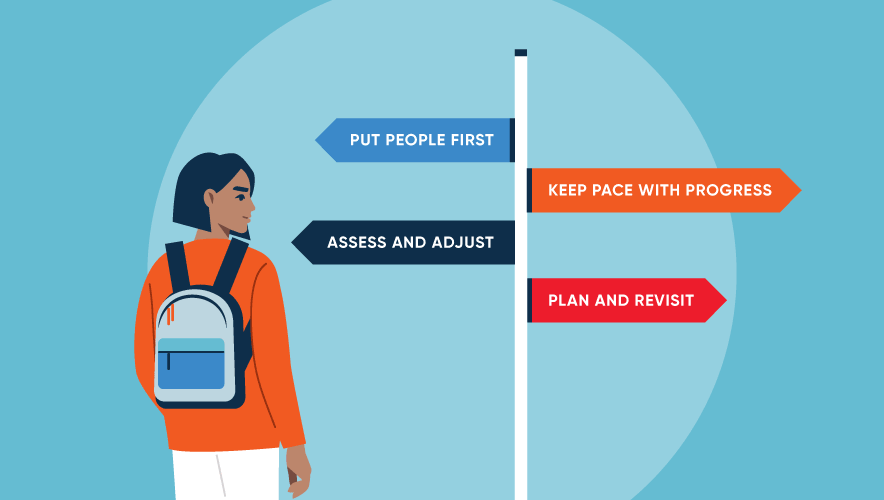Controlling Stress Responses for Better De-Escalation
John* was a veteran healthcare security professional with an exemplary record. But one day, a man with a known history of escalation began cursing and yelling at John. At some point during the verbal tirade, John snapped. He picked up the man and body-slammed him into a wall. Within 90 seconds he completely lost control, and because of it, he also lost his job.
The override mechanism that made John incapable of following his training can affect even the most seasoned security officer. Because of a peculiarity of human evolution, we still carry around primitive wiring that can cause us to fight, flight, or freeze.
Our brains are essentially an operating system, largely formed during thousands of years of tribal and feudal life, with a few new bits added later. This ancient, defensive part of our brains served us well when we needed to survive animal predators and competing humans, but it is less helpful in our civilized society.
We still carry around primitive wiring that can cause us to fight, flight, or freeze.
Once we enter this stress response, choices become limited. We either go too big or too small, instinctively sizing up our opposition. Whether we appease or vanquish the threat depends largely on how this situation reminds us of something we survived in the past. In other words, John was operating in survival mode.
Our brains are connected to the amygdala, which during a survival scenario releases hormones that can take over our thinking, bodily functions, and behaviors. Cortisol and adrenaline rush through our veins to trigger a reaction, and meanwhile our awareness in the frontal cortex lags by at least 20 minutes. Just like John, we rarely register a loss of our ability to reason, be flexible, or negotiate with others.
The Biology of Flight, Fight, and Freeze
Security officer Mary* was trying to deal with an angry parent. Despite the presence of other officers, Mary was the only target of verbal abuse. She completely lost control, and it required two colleagues to physically restrain her from attacking the parent.
Typical situations do not immediately trigger this overriding mechanism, otherwise we would all be running around like Lou Ferrigno in “The Incredible Hulk.” With proper awareness, building tension can be identified as the beginning of this biochemical domino effect. Catching it early offers a chance to stop ourselves from behaving unprofessionally.
Day-to-day, most of us are either in a calm or reactive mode. We cannot think rationally while in reactive mode because the body is preparing for battle or to escape from danger.
Afterward, our frontal cortex resumes control and often rationalizes our reactions. The objective truth becomes confused because we internally blur the lines between what we believe we must do to survive and how we were trained. Supervisors may hear about how the person was behaving in a threatening manner towards the officer or others, with the officer using phrases such as “coming at me” or that the antagonist was about to “hurt someone,” despite contrary objective evidence.
With proper response training, Mary might have realized that she was heading into a reactive mode and chosen a different response.
How to Respond, Not React
Another drawback of not keeping ourselves in check is that the person we are attempting to de-escalate will sense that we pose a threat. This makes it crucial to listen to our bodies’ increasing escalation levels, giving us a chance to recognize that we’re heading into reactive territory.
Once we realize we are reaching a reactive mode, we can tap out. Politely redirect the person antagonizing us to another member of the security team and step away. Now our colleagues can manage the hostile person. This can also de-escalate a target instead of putting them on the defensive.
The agitated person typically de-escalates after his or her original target is out of hearing range. In some instances, though, he or she will attempt to get a rise out of the new security officer, looking for new buttons to push. In cases where the original security officer was the source of agitation, the hostile person may resign to complaining about that officer and the situation diffuses.
While interventions are great in-the-moment tools, the best defense is prevention.
Security department leaders can establish processes for these situations and consider agreements among security officers that people swap out as the point person whenever one officer is either directly targeted or losing their grip on professionalism. Not only does this give us permission to be honest about the situations we are still learning to master, but it weakens anyone trying to get under our skin.
While interventions are great in-the-moment tools, the best defense is prevention. First, make the easy changes by improving workplace routines. Avoid working while hungry, over-caffeinated, or harried. These states are commonly associated with a loss of control.
Also, consider how we spend our time while not on the job because this is how our bodies restore their reserves. Having off-duty time to connect with others, sleeping well, and experiencing joy builds up our stress tolerance. If our off-duty time taxes our para-sympathetic nervous system—such as with excessive alcohol use, high-risk behaviors, poor sleep, and unhealthy diet—we will be less able to pause and reassess before reacting. Low-stress time off is also beneficial for general health. High levels of cortisol, a steroid hormone that can be produced during stress responses, have been scientifically proven to dramatically increase the risk for heart disease, early onset dementia, and poor stress management.
People with stressful jobs often find healthy off-duty choices a good way to achieve balance. Hobbies or activities that help them feel calm, grounded, and socially engages are a way to reduce job-related stress. (See Security Management’s July 2019 article, Under Pressure Managing Team Wellness for more information on how to help staff dealing with high or chronic stress while on the job.)
Lastly, identify what individual triggers are. The good news is that our response system is very predictable.
Think of the last time a triggering incident occurred. If that was when a large person started screaming, chances are the next time a big person screams, it will cause the same reaction. We can identify our triggers once we look objectively at how we handle different types of incidents.
Some of us may believe we cannot be triggered, but after asking coworkers to review security footage of previous incidents we may change our minds. We may identify that our body language was aggressive. Such a review will help us identify our triggers, create plans to support de-escalation from them, and make our coworkers aware of them.
It is also important to understand our cultural biases since these can also influence how we react to a potential security threat. Even if we eliminate all our triggers, we will still behave according to the ways we have been socialized. If we were raised in a culture that casts women as physically weak victims, for example, we may be less able to accurately assess the threat of a female assailant.
Also, when we are making split-second decisions in tense situations, our negative biases are more likely to show. If our bias perceives people who have a certain skin tone as armed or dangerous, we will overestimate the perceived threat and over-react. Bias-based blind spots can be removed; simply expect a longer, but worthwhile, journey.
As security personnel are expected to be responsive and nimble in the face of the unexpected, knowing how to de-escalate ourselves is key. Now that we recognize what reactive mode feels like, we can step back when we feel triggered and reset until we’re able to maintain personal control. Not only will we find this approach far more effective at neutralizing tension with others, but most importantly, it will bring out our best skills in the face of conflict.
*Names have been changed.
Self-Management in the Moment
Think of de-escalation like CPR and first aid: they cannot be administered if the immediate environment is unsafe, and you cannot de-escalate a situation if you are also at risk of being triggered.
Are you noticing certain symptoms of a flight or fight reaction? By combining self-awareness with in-the-moment-tricks, most people can stay in control and manage situations nonviolently. Some tools and tricks can also work to help calm you down before entering a situation or once you have removed yourself from a stressor:
- When you feel yourself get heated or feeling targeted, ask yourself: “Will this person’s words even matter to me 24 hours from now?” This not only gives your thinking brain (the frontal cortex) a chance to stay engaged, but it also helps you maintain your perspective.
- Control your body directly by taking four deep breaths. Silently count during the inhale and through the exhale, making the exhale twice as long.
- Practice a neurovascular hold. Place both hands on either ends of the scalp, one on your forehead, and one just above the neck. Then, apply gentle pressure for more than 30 seconds. This works well combined with deep breathing.
Kristine Scott is a conflict consultant who has trained hundreds on non-violent interventions based on negotiation and social psychology. She offers webinars, training videos, and management consulting through Seattle Conflict Resolution, supporting a wide range of teams, from the Seattle Space Needle to local charities. She is a published author, speaker, and advocate for non-physical intervention.
Special thanks to Jim Sawyer, director of security services for Seattle Children’s Hospital since 1975, who contributed to this article. He has been recognized by the Washington State Crime Prevention Association as Non-Law Enforcement Program of the Year, and also received the President’s Award for Crime Prevention Education, Crime Prevention Practitioner of the Year, Non-Law Enforcement Crime Prevention Business of the Year, and Lifetime Achievement Award of the Year.












